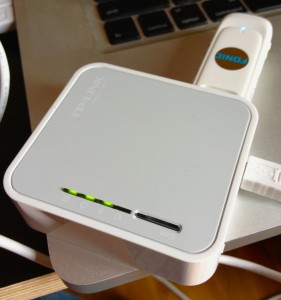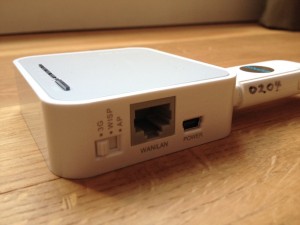Trainer recommendation: Making a WiFi network with a little box
 It’s the size of a Post-It note and makes a WiFi network using either a 3G mobile data SIM card or a local area network. Freelance trainer Guy Degen takes a look at the TP-Link 3G mobile wifi router – a useful bit of kit for journalists and journalism trainers on the road.
It’s the size of a Post-It note and makes a WiFi network using either a 3G mobile data SIM card or a local area network. Freelance trainer Guy Degen takes a look at the TP-Link 3G mobile wifi router – a useful bit of kit for journalists and journalism trainers on the road.
Participants shrieking “The internet is not working!” or “I can’t get online!” may make a mild mannered trainer somewhat concerned during an online journalism or mobile journalism workshop.
Despite your best efforts in planning and holding a workshop in a good location, internet access in your training room may crash at a critical moment. And it can happen anywhere: Berlin, Bishkek, Beirut, Bangalore or Bogota.
I’ve managed to avoid disaster a couple of times by quickly powering up a personal hotspot to create a mini WiFi network using a local mobile 3G SIM card and a MiFi. But my Novatel MiFi 2352 is still an expensive bit of kit (say around 100 Euro) and it doesn’t work in every country I visit.
So, what’s a good alternative?
A little box for WiFi solutions
The TP-Link 3G mobile router is an interesting little box.
It can be powered in a fixed location using mains power supply. Or, you can take it on the move using the USB port on a laptop.
To generate a WiFi network, all you have to do is plug a 3G mobile data surf stick into the USB port on the side. Or, you plug in an ethernet cable that is connected to a local area network (LAN). Several devices can connect simultaneously. And, the manufacturer boasts it can deliver up to 150 Mbps.
Depending on the local mobile network data speed available, this could be a good back up for training rooms. The system settings offer an easy set-up function that lists the access point name and passwords of major mobile network providers. There’s also a custom set up mode if you need to manually enter a network’s APN and password.
And if you find yourself in a hotel that only provides internet access via an ethernet cable you could create your own WiFi network. No more being tethered to the desk and a cable.
I’ve also successfully operated the router using a PowerMonkey external power pack that has a 5V output.
You can check out the full features here.
With a USB surf stick connected to the router it’s obviously not as pocketable as something like a MiFi, but for around 30 euro, it’s an inexpensive little box I’ll keep in my kit bag.
Author: Guy Degen




Feedback